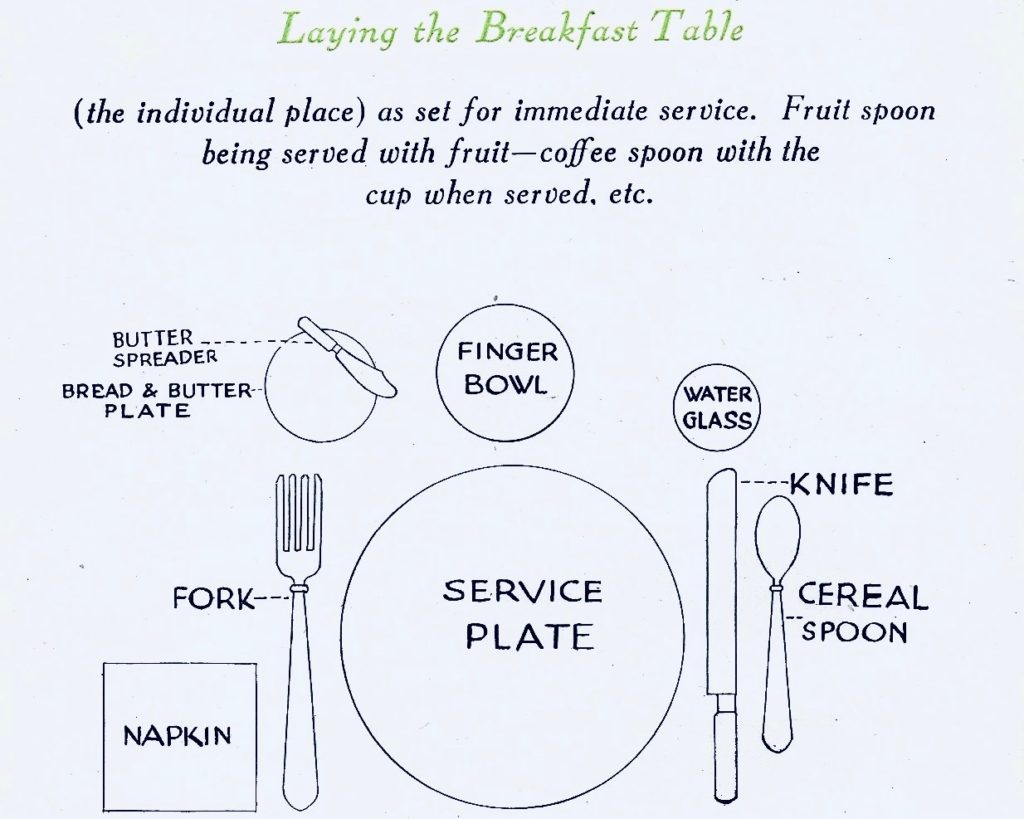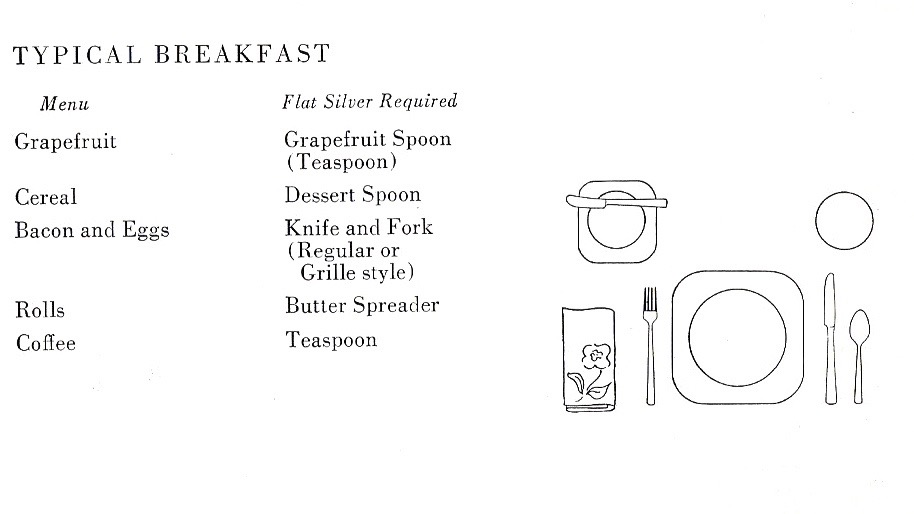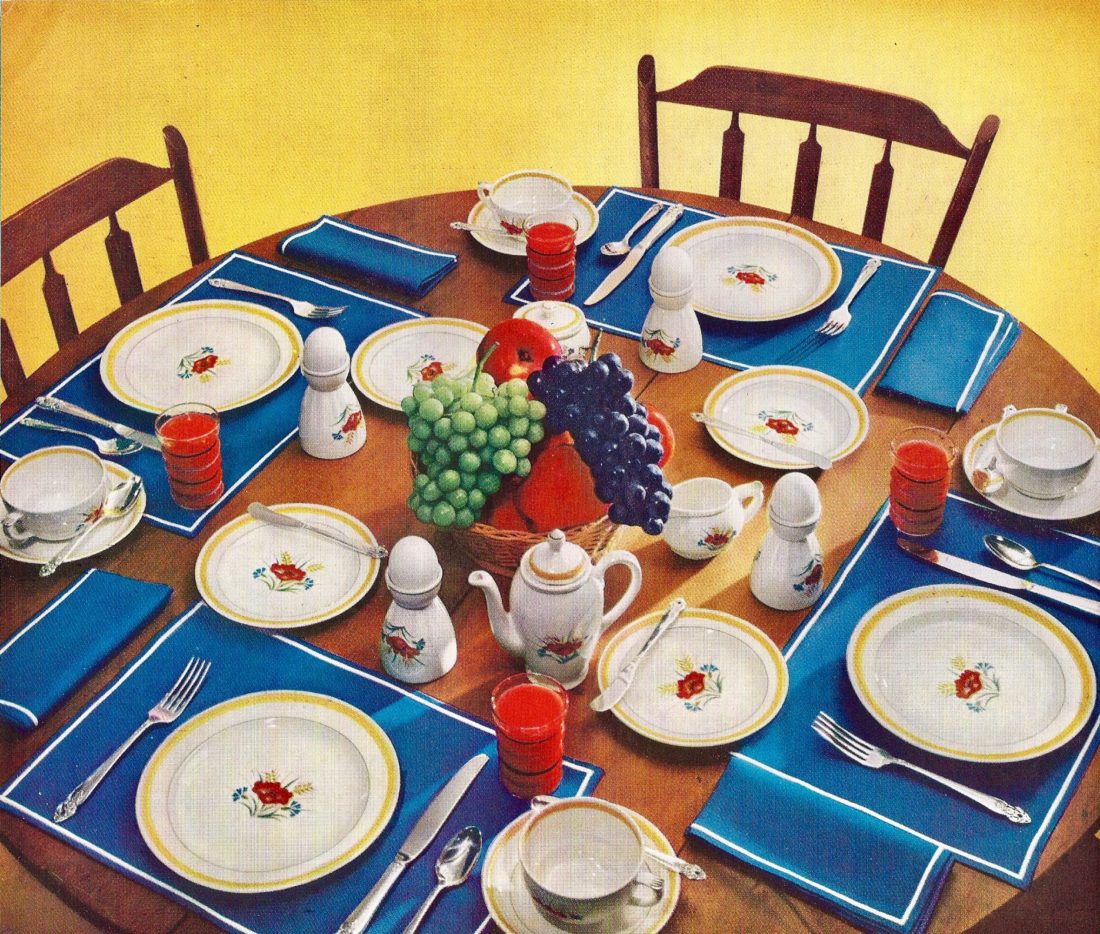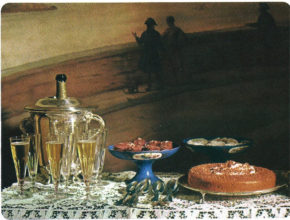“This really is the same as the formal Luncheon except the men are invited with the ladies, and coffee is served throughout the meal.
The table may be covered or bare. If bare, use doilies for plates and glasses. The arrangement of the cover is the same as for the formal dinner. Lighter dishes are served for luncheon than for dinner; entrees take the place of the roast. Soup or bouillon is served in cups. Fruit may be served for the first course instead of canapés. the hostess sometimes serves the salad and the coffee, but it is better to have all serving from the side.”
Lowey’s Cook Book by Maria Willitt Howard, (1912)
“The breakfast cloth should, above all, be gay. If we need gayety at any one time more than another it is in the morning when our spirits are likely to be a little low. The size and shape of the cloth will depend on the size and shape of your table. It takes some time and a little thought to have on hand the right kind of linens and the right kind of centerpieces for different meals and different occasions, but it pays.”
Table Serving and Setting by Della Thompson Lutes, (1930)
Della isn’t wrong. My spirits are definitely a little low in the morning. That said, I don’t intend to spring out of bed, put a cloth on the table and cook a full breakfast for twelve. Should that day ever occur that I do, this is how Della says I should set the table:
“At the right of the plate are the knife, the cereal spoon, and the grapefruit spoon. The silver for any fruit course would be placed on the outside, whether knife, fork or spoon. At the left of the plate the forks are placed. And next to these the napkin. If there were to be no fruit course and cereal were to be served after the people sit down, the napkin might be placed on the service plate. Just above the service plate at the left and at the tip of the fork is the bread and butter plat with the spreader laid at the edge and in parallel line with the other silver. A ball or cube of butter is placed on the plate just before the guests are seated. At the right of the plate and at the tip of the knife is the water glass. Finger bowls are not used as generally as they once were, but are desirable for some fruit courses. They should be placed just above the plate. Salts and peppers may be individual and near the finger bowl or between each two covers.”

As you can see from the illustration above, Della Lutes was not talking crazy when she said finger bowls were once used at breakfast. Indeed, there are only twelve years between when Sara Adams has them listed as a necessity in 1918 and Della tells us that they’re “not as generally used” in 1930. Those twenties really altered everything didn’t they?
Placemats were an option since they rose to popularity at the turn of the century, but oddly enough, they were connected to very formal events at first. The ability to have a gorgeous table that bore not only close scrutiny by diners but also having the staff to fix any scrapes that might occur during a meal was a luxury. A bare table was a statement. But as with so many things over time, place cloths became a fun and casual accessory that denoted a less formal event by the mid-twentieth century.
By the forties, tablecloths stopped being required at breakfast even for chi-chi guests and placemats became the popular option for breakfasts. Breakfast had become plainer, even in its party incarnation, with people expecting a simpler meal served in a much more casual style.
Al Fresco breakfast parties began to be the norm in warm weather sometime around the Edwardian period and even these, over time, became less formal. As you’ll read below, by the 1930s they were de rigueur.
“These breakfasts are not the early kind where one breaks one’s fast with a cup of tea or coffee and the roll or slice of toast. they are sometimes quite elaborate and they take place any time from ten to twelve-thirty. They may be served in the house in winder but never in summer. The “al fresco” breakfast is a deservedly popular repast. the table should be set and served almost as for luncheon, but the food is not the same. Fruit is served, and perhaps after the fruit a mild hors d’oeuvres, but no soup. We may then have fish of any kind, broiled or sautéd, or kidneys broiled or deviled, with an accompaniment of cucumbers or tomatoes in French dressing. With these may be served hot rolls, muffins, or gems, then we may have lamb chops, little tenderloins of beef, or small veal cutlets, and mushrooms, with potatoes cooked in any f the hundred different ways except plain mashed. The next course may be chicken broiled or sautéed or fried with hominy or rice, and the coffee in breakfast cups, hot rich, and deep amber for those who take cream. Will will finish with any of the omelette soufflés with jam or fruit, or we may omit either the fish, meat, or chicken course and have a savory omelette. In this case we would finish with hot waffles with maple sugar, or with sugar and cinnamon or vanilla sugar, or with any of the good American griddle cakes with maple sirup to pour over them. If in season, a strawberry or any fresh fruit shortcake may be served, if it be made with biscuit crust.”
The New Hostess of To-Day by Linda Hull Larned, 1931
WWII introduced Americans to the European breakfast of pastry or baguette, fruit, a boiled egg and coffee, which began to show up on sophisticated tables soon after.

Now that you know, you can toss all of this info out of the window and have some friends round for a casual brunch. But should you decide to hold a formal breakfast this summer, send me pictures, this I want to see!
Much love and looking forward to all of us getting out there and entertaining soon! Cheri


